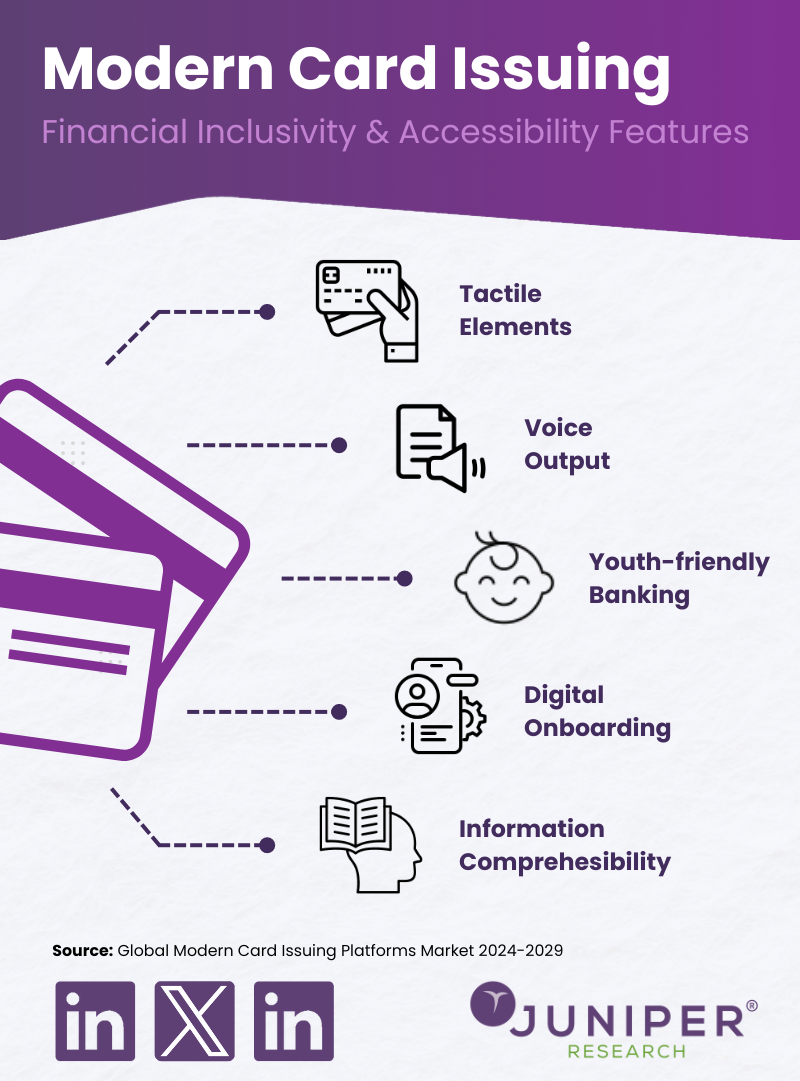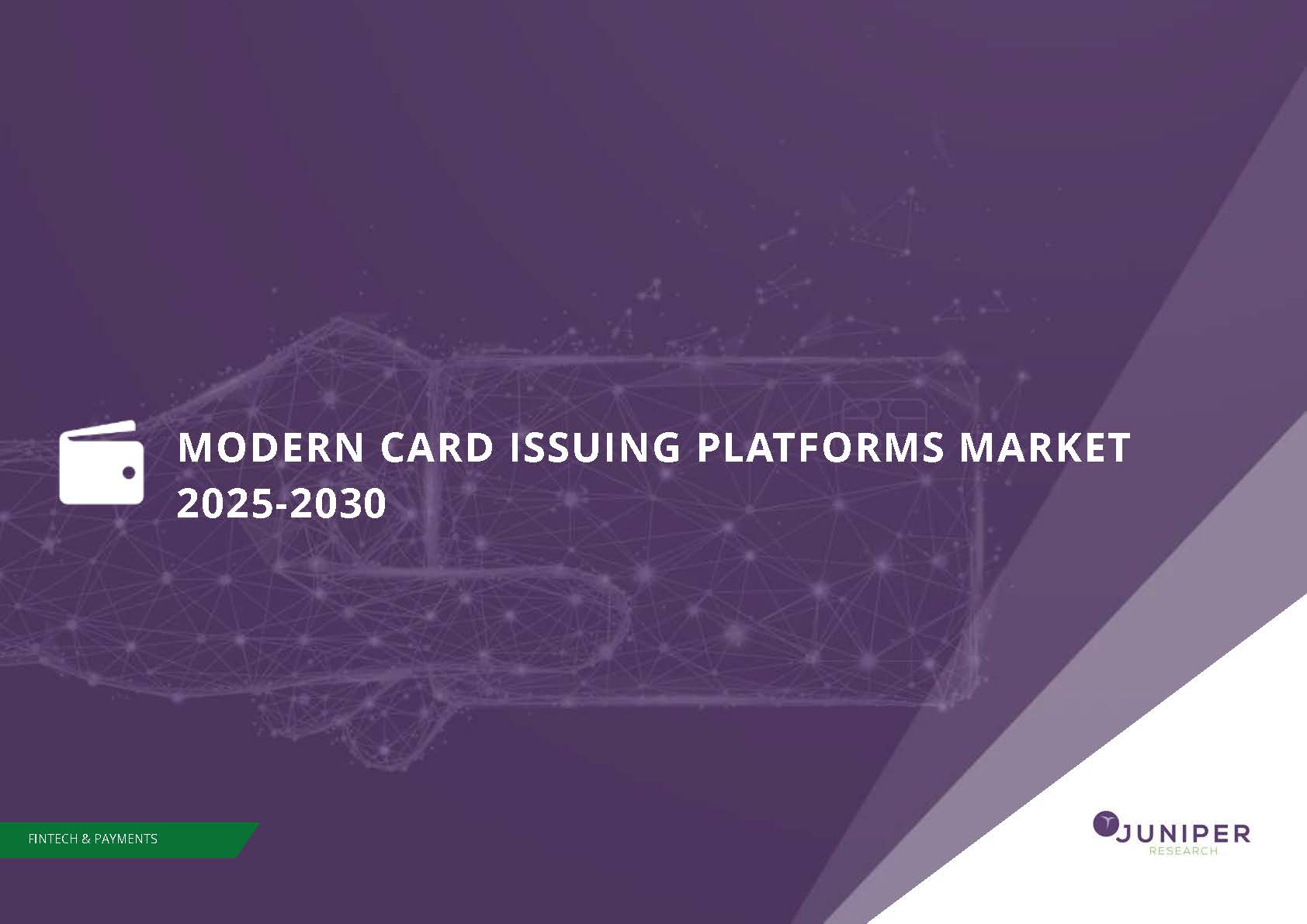Modern Card Issuing: Financial Inclusivity & Accessibility Features


Developing an accessible payment ecosystem is important because it increases financial inclusion and raises brand awareness, expanding the customer base. Furthermore, taking social and ethical responsibility is important when it comes to aligning with consumer values, which is becoming increasingly important for consumers when choosing their bank. This is especially the case for younger generations; when surveying Gen Z across the UK, Germany, and Spain, Insider Intelligence found that 64% of Gen Z would switch banks if their current provider didn’t meet their ethical standards.
Regulatory provisions surrounding accessibility have the potential to impact the operation of banks and financial services, making it increasingly important that these institutions prioritise accessible payments. The EAA (European Accessibility Act) requires businesses to make their services more accessible and implement the measures outlined in the act by 2025. The most relevant aspects for banking revolve around making information displays intuitive and making physical payment machines usable for those with impairments.
The ability to work with APIs makes modern card issuing platforms uniquely tailored to be able to design cards which are more useable for populations with disabilities. One example is the Thales Gemalto Voice Payment Card, designed for the blind and visually impaired. This connects to an app on the cardholder’s phone via bluetooth and vocalises the amount of the transaction, preventing fraud or mistakes at POS.
Other physical payment innovations created by modern card issuing include notches at the top of the card in order to aid blind people in identifying the correct payment card and having the option for larger font or braille on the card. An example of this is Giesecke + Devrient’s Convego SenseDot Cards, which have embossed bumps applied at point of personalisation to help customers differentiate between cards.
Onboarding is another aspect which can be affected by these regulations due to their requirement for information to be inclusive and easily understood. One way to fulfil this regulation is to have the option to send onboarding information in Braille or to add a QR code allowing the information to be accessed aurally.
Another factor which makes modern cards more widely accessible is their previously discussed convenience, especially during the onboarding process. The physical nature of traditional card issuers provides barriers to different sections of the populace; for example, going to a physical bank branch may be a barrier to accessing a card for rural populations and those at work during bank opening hours. Furthermore, the requirement for a home address to deliver the card to may not be able to be met by some sectors of the population, leaving them underbanked. Due to this, modern card issuing is a method of increasing financial inclusion.
Source: Global Modern Card Issuing Platforms Market 2024-2029
Download the Whitepaper: Modern Card Issuing: A Personalisation Revolution
Latest research, whitepapers & press releases
-
 ReportDecember 2025
ReportDecember 2025AI Agents for Customer Experience Platforms Market: 2025-2030
Our comprehensive AI Agents for Customer Experience Platforms research suite comprises detailed assessment of a market that is set to disrupt mobile communications. It provides stakeholders with insight into the key opportunities within the AI agents for customer experience platforms market over the next two years.
VIEW -
 ReportDecember 2025Fintech & Payments
ReportDecember 2025Fintech & PaymentseCommerce Fraud Prevention Market: 2025-2030
Our eCommerce Fraud Prevention research suite provides a detailed and insightful analysis of this evolving market; enabling stakeholders from financial institutions, law enforcement agencies, regulatory bodies and technology vendors to understand future growth, key trends, and the competitive environment.
VIEW -
 ReportNovember 2025Telecoms & Connectivity
ReportNovember 2025Telecoms & ConnectivityeSIMs & iSIMs Market: 2025-2030
Juniper Research’s eSIMs and iSIMs research suite offers insightful analysis of a market set to experience significant growth in the next five years. The research suite provides mobile network operators (MNOs), original equipment manufacturers (OEMs), and eSIM management and platforms vendors with intelligence on how to capitalise on the market growth, and guidance on how eSIM-only devices and sensors, SGP.42, in-factory provisioning, and iSIMs will change the competitive landscape.
VIEW -
 ReportNovember 2025Fintech & Payments
ReportNovember 2025Fintech & PaymentsModern Card Issuing Platforms Market: 2025-2030
Our Modern Card Issuing Platforms Market research suite provides a detailed and insightful analysis of this evolving market; enabling stakeholders from banks, financial institutions, fintech companies, and technology vendors to understand future growth, key trends, and the competitive environment.
VIEW -
 ReportNovember 2025Fintech & Payments
ReportNovember 2025Fintech & PaymentsDigital Wallets Market: 2025-2030
Our digital wallets research suite provides detailed analysis of this rapidly changing market; allowing digital wallet providers to gain an understanding of key payment trends and challenges, potential growth opportunities, and the competitive environment.
VIEW -
 ReportOctober 2025Fintech & Payments
ReportOctober 2025Fintech & PaymentsDigital Identity Market: 2025-2030
Juniper Research’s Digital Identity research suite provides a comprehensive and insightful analysis of this market; enabling stakeholders, including digital identity platform providers, digital identity verification providers, government agencies, banks, and many others, to understand future growth, key trends, and the competitive environment.
VIEW
-
 WhitepaperDecember 2025Telecoms & Connectivity
WhitepaperDecember 2025Telecoms & ConnectivityHuman + AI: Drivers of Customer Experience AI Agents in 2026
Our complimentary whitepaper, Human + AI: Drivers of Customer Experience AI Agents in 2026, examines the key drivers of the AI agents for customer experience platforms market in 2025.
VIEW -
 WhitepaperDecember 2025Fintech & Payments
WhitepaperDecember 2025Fintech & PaymentsBeyond Chargebacks: The True Cost of Fraud for Digital Commerce
Our complimentary whitepaper, Beyond Chargebacks: The True Cost of Fraud for Digital Commerce, examines the state of the eCommerce fraud prevention market; considering the impact of evolving digital fraud strategies, including key trends such as identity theft, account takeovers, chargebacks, policy abuse and friendly fraud.
VIEW -
 WhitepaperNovember 2025Telecoms & Connectivity
WhitepaperNovember 2025Telecoms & ConnectivityeSIM-only Devices: The Impact on Operators, Consumers, and IoT
Our complimentary whitepaper, eSIM-only Devices: The Impact on Operators, Consumers, and IoT, explores the challenges and opportunities for the three segments, with a particular focus on eSIM-only smartphones and SGP.42.
VIEW -
 WhitepaperNovember 2025Fintech & Payments
WhitepaperNovember 2025Fintech & PaymentsUnlocking the Next Stage of Growth for Modern Card Issuing Platforms
This free whitepaper analyses key trends shaping the modern card issuing space, and the ways in which modern card issuing platforms can capture growth.
VIEW -
 WhitepaperNovember 2025Fintech & Payments
WhitepaperNovember 2025Fintech & PaymentsTop 10 Fintech & Payments Trends 2026
Fintech is evolving fast. From stablecoins to agentic AI, our annual guide reveals the shifts redefining payments, digital identity, and the future of money in 2026. Download your copy today.
VIEW -
 WhitepaperNovember 2025Fintech & Payments
WhitepaperNovember 2025Fintech & PaymentsDigital Wallets: Empowering Financial Inclusivity
Our complimentary whitepaper, Digital Wallets: Empowering Financial Inclusivity, examines the state of the digital wallets market; considering the impact of digital wallets on different geographies, how they are shaping the modern payments landscape through lower transaction fees and promoting financial inclusivity for underbanked populations, and how they are competing with established payment methods.
VIEW
-
IoT & Emerging Technology
Juniper Research Unveils Top 10 Emerging Tech Trends to Watch in 2026
January 2026 -
Fintech & Payments
Digital Identity App Usage to Hit 6.2 Billion by 2030, Driven by Shift to Decentralised Models
December 2025 -
Telecoms & Connectivity
Travel eSIM Margins Under Pressure as Revenue per Gigabyte Falls 10% Globally in Two Years
December 2025 -
Telecoms & Connectivity
AI Agents to Power 1,000% More Customer Interactions for Enterprises Globally by 2027
December 2025 -
IoT & Emerging Technology
Global D2C Revenue Set for $370 Million Surge, But Satellite Operators Should Not Chase Full MNO Status
December 2025 -
Fintech & Payments
Digital Goods Fraud to Cost eCommerce Merchants $27 Billion Globally by 2030 as AI Tools Accelerate Attacks
December 2025




















